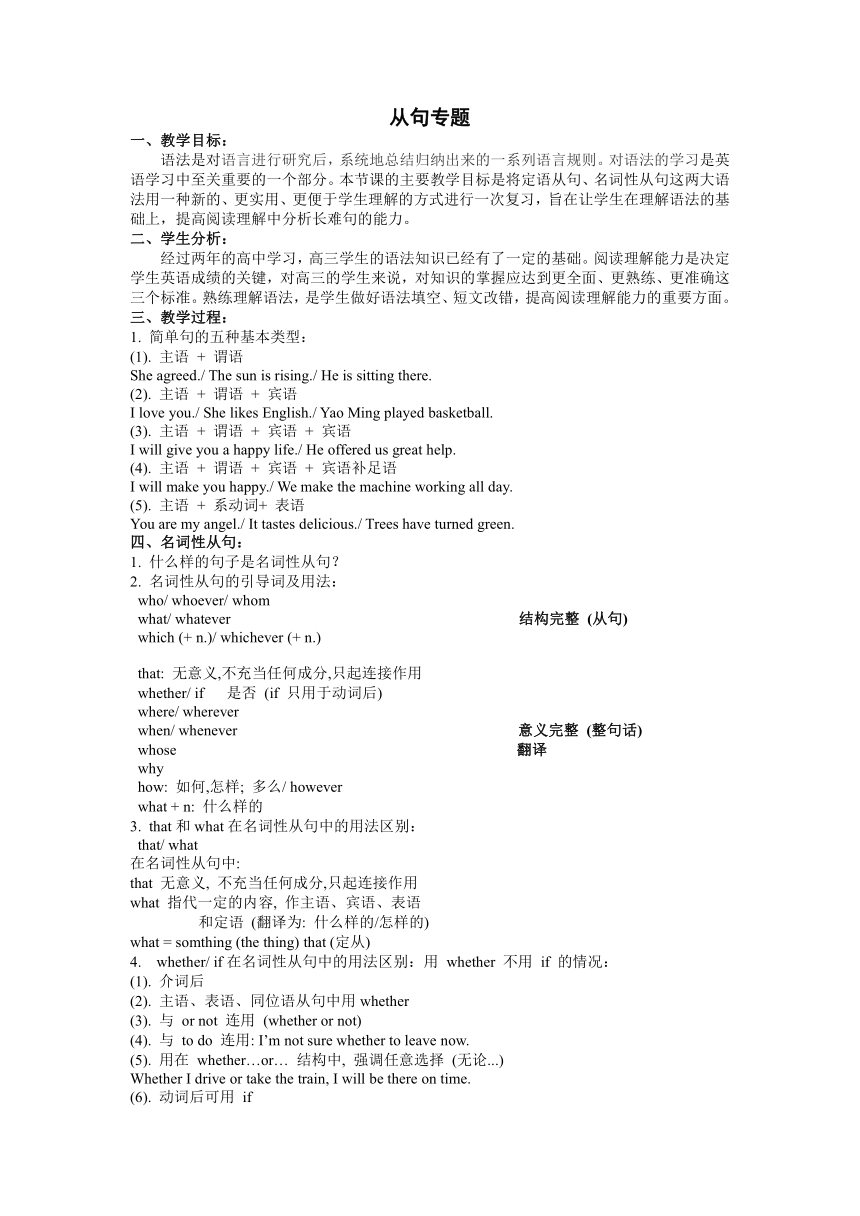2022届高考英语二轮复习:从句专题教案
文档属性
| 名称 | 2022届高考英语二轮复习:从句专题教案 |  | |
| 格式 | docx | ||
| 文件大小 | 21.3KB | ||
| 资源类型 | 教案 | ||
| 版本资源 | 通用版 | ||
| 科目 | 英语 | ||
| 更新时间 | 2022-02-27 17:25:45 | ||
图片预览

文档简介
从句专题
教学目标:
语法是对语言进行研究后,系统地总结归纳出来的一系列语言规则。对语法的学习是英语学习中至关重要的一个部分。本节课的主要教学目标是将定语从句、名词性从句这两大语法用一种新的、更实用、更便于学生理解的方式进行一次复习,旨在让学生在理解语法的基础上,提高阅读理解中分析长难句的能力。
学生分析:
经过两年的高中学习,高三学生的语法知识已经有了一定的基础。阅读理解能力是决定学生英语成绩的关键,对高三的学生来说,对知识的掌握应达到更全面、更熟练、更准确这三个标准。熟练理解语法,是学生做好语法填空、短文改错,提高阅读理解能力的重要方面。
教学过程:
简单句的五种基本类型:
(1). 主语 + 谓语
She agreed./ The sun is rising./ He is sitting there.
(2). 主语 + 谓语 + 宾语
I love you./ She likes English./ Yao Ming played basketball.
(3). 主语 + 谓语 + 宾语 + 宾语
I will give you a happy life./ He offered us great help.
(4). 主语 + 谓语 + 宾语 + 宾语补足语
I will make you happy./ We make the machine working all day.
(5). 主语 + 系动词+ 表语
You are my angel./ It tastes delicious./ Trees have turned green.
名词性从句:
什么样的句子是名词性从句?
名词性从句的引导词及用法:
who/ whoever/ whom
what/ whatever 结构完整 (从句)
which (+ n.)/ whichever (+ n.)
that: 无意义,不充当任何成分,只起连接作用
whether/ if 是否 (if 只用于动词后)
where/ wherever
when/ whenever 意义完整 (整句话)
whose 翻译
why
how: 如何,怎样; 多么/ however
what + n: 什么样的
that和what在名词性从句中的用法区别:
that/ what
在名词性从句中:
that 无意义, 不充当任何成分,只起连接作用
what 指代一定的内容, 作主语、宾语、表语
和定语 (翻译为: 什么样的/怎样的)
what = somthing (the thing) that (定从)
whether/ if在名词性从句中的用法区别:用 whether 不用 if 的情况:
(1). 介词后
(2). 主语、表语、同位语从句中用whether
(3). 与 or not 连用 (whether or not)
(4). 与 to do 连用: I’m not sure whether to leave now.
(5). 用在 whether…or… 结构中, 强调任意选择 (无论...)
Whether I drive or take the train, I will be there on time.
(6). 动词后可用 if
定语从句
什么样的句子是定语从句?
定语从句的引导词及用法:
关系代词:
that
which
who 结构完整 (从句)
whom
whose + 名词
关系副词:
when
where 意义完整 (整句话)
Why 翻译
= 介词 + which
that和which在定语从句中的区别:
(1). 用that不用which的情况:
1). 先行词为不定代词all (all+n), much (much+n), everything, something, anything, nothing, none, the one;
2). 先行词是the only+n, the very+n;
3). 先行词是the first, the second 或the first+n, the second+n;
4). 先行词是最高级或最高级+n;
5). 先行词既有人又有物;
6). 作表语用that
China is no longer the country that it used to be.
(2). 用which不用thatd的情况:
1). 非限制性定语从句 (,后) 用which, which可指代整句话的内容;
2). 介词 + which
六:从句做题方法总结:
1、先判断是什么从句;
2、判断从句结构是否完整;
3、翻译整句话, 看整句话意义是否完整。
教学目标:
语法是对语言进行研究后,系统地总结归纳出来的一系列语言规则。对语法的学习是英语学习中至关重要的一个部分。本节课的主要教学目标是将定语从句、名词性从句这两大语法用一种新的、更实用、更便于学生理解的方式进行一次复习,旨在让学生在理解语法的基础上,提高阅读理解中分析长难句的能力。
学生分析:
经过两年的高中学习,高三学生的语法知识已经有了一定的基础。阅读理解能力是决定学生英语成绩的关键,对高三的学生来说,对知识的掌握应达到更全面、更熟练、更准确这三个标准。熟练理解语法,是学生做好语法填空、短文改错,提高阅读理解能力的重要方面。
教学过程:
简单句的五种基本类型:
(1). 主语 + 谓语
She agreed./ The sun is rising./ He is sitting there.
(2). 主语 + 谓语 + 宾语
I love you./ She likes English./ Yao Ming played basketball.
(3). 主语 + 谓语 + 宾语 + 宾语
I will give you a happy life./ He offered us great help.
(4). 主语 + 谓语 + 宾语 + 宾语补足语
I will make you happy./ We make the machine working all day.
(5). 主语 + 系动词+ 表语
You are my angel./ It tastes delicious./ Trees have turned green.
名词性从句:
什么样的句子是名词性从句?
名词性从句的引导词及用法:
who/ whoever/ whom
what/ whatever 结构完整 (从句)
which (+ n.)/ whichever (+ n.)
that: 无意义,不充当任何成分,只起连接作用
whether/ if 是否 (if 只用于动词后)
where/ wherever
when/ whenever 意义完整 (整句话)
whose 翻译
why
how: 如何,怎样; 多么/ however
what + n: 什么样的
that和what在名词性从句中的用法区别:
that/ what
在名词性从句中:
that 无意义, 不充当任何成分,只起连接作用
what 指代一定的内容, 作主语、宾语、表语
和定语 (翻译为: 什么样的/怎样的)
what = somthing (the thing) that (定从)
whether/ if在名词性从句中的用法区别:用 whether 不用 if 的情况:
(1). 介词后
(2). 主语、表语、同位语从句中用whether
(3). 与 or not 连用 (whether or not)
(4). 与 to do 连用: I’m not sure whether to leave now.
(5). 用在 whether…or… 结构中, 强调任意选择 (无论...)
Whether I drive or take the train, I will be there on time.
(6). 动词后可用 if
定语从句
什么样的句子是定语从句?
定语从句的引导词及用法:
关系代词:
that
which
who 结构完整 (从句)
whom
whose + 名词
关系副词:
when
where 意义完整 (整句话)
Why 翻译
= 介词 + which
that和which在定语从句中的区别:
(1). 用that不用which的情况:
1). 先行词为不定代词all (all+n), much (much+n), everything, something, anything, nothing, none, the one;
2). 先行词是the only+n, the very+n;
3). 先行词是the first, the second 或the first+n, the second+n;
4). 先行词是最高级或最高级+n;
5). 先行词既有人又有物;
6). 作表语用that
China is no longer the country that it used to be.
(2). 用which不用thatd的情况:
1). 非限制性定语从句 (,后) 用which, which可指代整句话的内容;
2). 介词 + which
六:从句做题方法总结:
1、先判断是什么从句;
2、判断从句结构是否完整;
3、翻译整句话, 看整句话意义是否完整。
